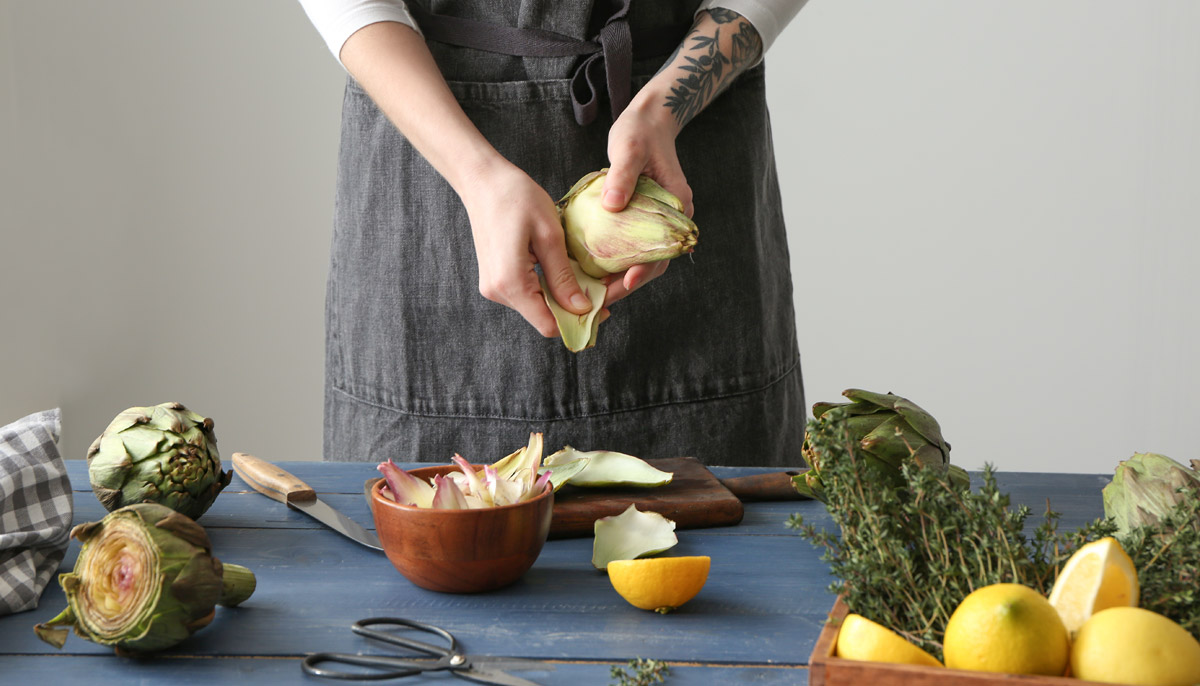Shutterstock
From our friends at Hey, Pumpkin:
If you weren’t raised on the wonder that is the artichoke, you’d be forgiven for thinking their only place is on the end of a chip in the form of spinach and artichoke dip.

And while I’ll never speak against that culinary wonder (dips are life, after all), the Super Bowl is over, and there are so many more delicious ways to prepare this odd-looking vegetable.
Not to mention, they pack a serious nutritious punch. They might not leap to mind when you think of the term “super foods” but they totally should. So be they roasted, steamed, grilled, marinated, or pickled — today, we’re talking about five reasons you should definitely be eating more delicious artichokes. You’re welcome.
Artichokes contain both soluble and insoluble fiber, both of which keep things, um, moving along smoothly. They also contain inulin, a type of soluble fiber, which is a prebiotic. Prebiotics feed the “good” bacteria in your gut, helping to balance your microbiome. This helps us metabolize nutrients and ward off gastrointestinal woes like irritable bowel syndrome. All of that fiber can be a little rough if you have a sensitive tummy, though, so if you’ve already been diagnosed with IBS they might not be the best idea.
The soluble fiber in artichokes can also support heart health. It binds with LDL, or “bad” cholesterol, which keeps your body from absorbing it. This lowers LDL in the blood, which can help to reduce your risk of heart disease. Artichokes can even help to manage your blood pressure. The veggie is rich in potassium, which counteracts the effect of excess sodium in the body, thus reducing overall blood pressure.
Artichokes are jam-packed with antioxidants like vitamin A and C as well as iron. Antioxidants can help to combat oxidative stress and free radicals, things that can increase your risk of cancer and other chronic conditions. This funny looking veggie also contains plant compounds like gallic acid, quercetin, and rutin which are thought to have antioxidant and anti-cancer properties.
All that fiber – which is really what makes the artichoke a superstar – slows down the absorption of sugar in the blood, helping to keep your blood glucose levels under control, even on an empty stomach. Which is huge, because when blood glucose levels are high it can indicate you have prediabetes, which can be a precursor of type 2 diabetes, heart disease, and stroke.
Again, if you weren’t raised on artichokes, they might seem a little challenging at first. I find that most people eat just the hearts, which you can find frozen, canned, marinated, or pickled at most stores. But I always loved the process of pulling off the petals and scraping off the “meat” with my teeth before working down to the heart. And actually, it turns out that if you skip that part you’re throwing away other helpful nutrients that reside in the leaf extract.
If you pick them up whole at the store, then you’ll want to cut off the top quarter-inch or so, and also snip off the sharp pointy parts of the leaves around it. I like to put my thumbs in the middle and spread the leaves out a bit, and then add a garlic clove, salt and pepper, and maybe some lemon into the center.
My mom used to make them in the pressure cooker (which at the time was a risky bomb-like apparatus that would make us flee the kitchen while it was in use). She would serve them whole with a side of lemon butter or vinaigrette for dipping.
You can do this in your Instant Pot, or even just steam them, for the same effect. You can also wrap them in foil and roast them, or even cut them down the center and grill them.
And if you do opt for the pre-trimmed canned, pickled, or marinated kind, they’re absolutely delicious roasted, sauteed, or added to salads. Just be wary of the added sodium — you might want to rinse them before you prepare them.
Of course, you could also add them to spinach and a bunch of cheese and throw that whole delicious mess in the oven. I’m certainly not gonna judge.